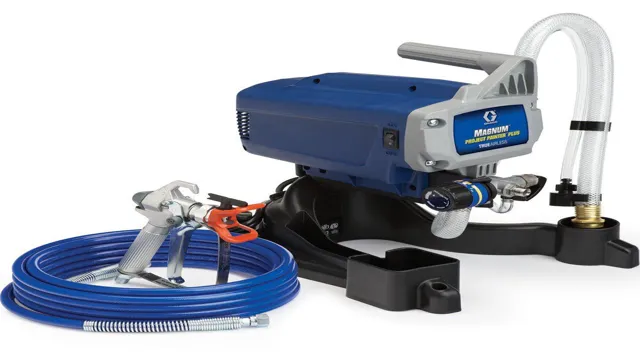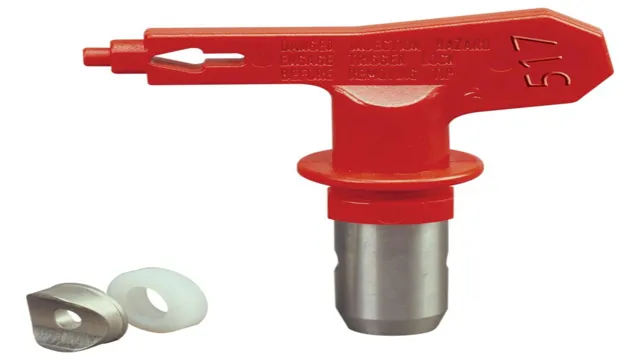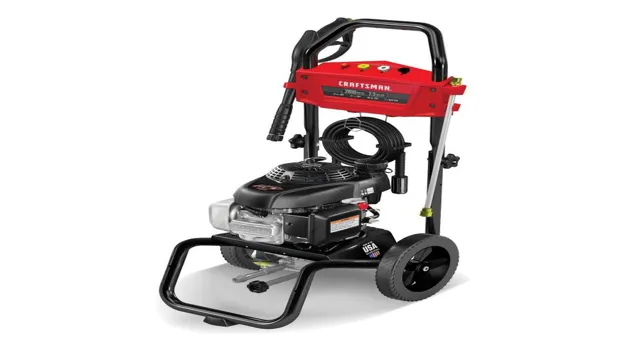
Painting is a great way to update the look of your space without breaking the bank. But sometimes, despite using the best paint and equipment, things don’t go as smoothly as you hoped. One of the problems that can arise is paint splattering from your paint sprayer.
It’s frustrating when you’re trying to get a nice, even coat but instead, you end up with blobs of paint all over your surface. So, why is your paint sprayer splattering paint? In this blog post, we’ll explore the various causes of paint splatter and provide you with tips to prevent it from happening in the future.
Introduction
If you’ve noticed that your paint sprayer is splattering paint instead of producing a smooth, even finish, you’re not alone. This issue can be frustrating and can lead to a lot of wasted time and materials. There are several reasons why your paint sprayer may be splattering paint, including issues with the equipment itself, problems with the paint you’re using, or operator error.
One possible cause is that the nozzle on your sprayer is clogged or partially blocked, preventing the paint from flowing through smoothly. Another issue could be that you’re using a paint that is too thick or has not been properly mixed. Additionally, if you’re holding the sprayer too close or moving it too quickly, this can also lead to splattering.
To avoid splattered paint, it’s important to use proper technique and equipment, and to ensure that the paint you’re using is compatible with your sprayer.
Understanding the Spraying Technique
Spraying technique When it comes to painting or varnishing, a key aspect of the process is the spraying technique. This refers to the method used to apply the paint or varnish onto the surface, and it can greatly impact the final result. Understanding the spraying technique involves knowing things like the appropriate distance to hold the spray gun from the surface, the angle at which to spray, and the speed at which to move the gun.
A proper spraying technique ensures an even coverage and a smooth finish, while a poor technique can result in blotchy or uneven coverage. By mastering the spraying technique, you can achieve professional-looking results in your painting and varnishing projects. So, take the time to learn the basics of spraying technique and practice to improve your skills.

Types of Paint Sprayers
Paint sprayers are an essential tool for any DIY enthusiast or professional painter. They offer a quick and efficient way to apply paint to surfaces, saving time and producing a beautiful finish. There are several types of paint sprayers to choose from, each with their own strengths and weaknesses.
It can be overwhelming when trying to decide which one to purchase, but with the right information, it’s easier to make an informed decision. In this blog section, we’ll explore the different types of paint sprayers and help you choose the perfect one for your needs.
Common Reasons Why Paint Sprayer Splatters Paint
Are you struggling with paint splatters when using a paint sprayer? Well, you’re not alone. Many people face this issue and wonder what they’re doing wrong. One of the most common reasons why paint sprayer splatters paint is the thickness of the paint.
If the paint is too thick, it won’t spray evenly, which can lead to splatters. Another reason could be the pressure on the sprayer. If the pressure is too high, the paint will come out in bursts and cause splatters.
Additionally, if the sprayer’s nozzle is damaged, it may cause the paint to spray unevenly and lead to splatters. Before using a paint sprayer, it’s essential to ensure that your paint is thinned correctly, the pressure is set appropriately, and the nozzle is in good condition. With these precautions, you can avoid paint splatters and ensure a smooth finish on your project.
Steps to Prevent Paint Sprayer from Splattering Paint
If you’re wondering why your paint sprayer is splattering paint instead of giving you a smooth, even finish, there are a few steps you can take to prevent this from happening. Firstly, make sure you’re using the right type of paint for your sprayer – not all paints are suitable. Secondly, check that the nozzle is clean and free from blockages.
A clogged nozzle can cause paint to splatter or spit out. Thirdly, ensure that you’re using the correct pressure setting on your sprayer. Too much pressure can cause the paint to splatter, and too little can result in an uneven finish.
Finally, maintain a consistent distance between the sprayer and the surface you’re painting. Too close and the paint will splatter, too far and you won’t get an even coat. By following these simple steps, you can ensure that your paint sprayer delivers the perfect finish every time.
Properly Mix Your Paint
When it comes to using a paint sprayer, one of the biggest frustrations is dealing with splattering paint. Not only does it make a mess, but it also results in an uneven finish that requires more time and effort to fix. To prevent this from happening, it’s important to properly mix your paint before loading it into the sprayer.
Start by using a paint mixer to blend the paint thoroughly, making sure there are no clumps or lumps. Then, strain the paint through a fine mesh filter to remove any remaining impurities. Finally, add the appropriate amount of thinner to the mixture to achieve the right consistency for spraying.
By taking these steps before using your paint sprayer, you’ll minimize the risk of splattering and achieve better results in less time.
Check the Paint Viscosity
When using a paint sprayer, a common issue that many people face is paint splattering. This can cause an uneven finish and make your paint job look unprofessional. However, by taking a few simple steps, you can prevent this from happening.
One crucial step to preventing paint splattering is to check the viscosity of your paint. Viscosity refers to how thick or thin your paint is. If the paint is too thin, it will spatter, and if it is too thick, it will be difficult to spray.
To check the viscosity, you can use a viscosity cup or a simple stir stick. Dip the cup or stick into the paint and then slowly lift it out. The slower the paint runs off the cup or stick, the thicker it is.
If the paint runs off quickly, it is too thin, and you will need to add a thicker medium to it. By taking the time to check your paint viscosity, you can achieve a smooth and even finish and avoid the frustration of uneven splattering.
Clean the Paint Sprayer
When working with a paint sprayer, it’s important to keep it clean. Not only does this prevent clogs and maintain the sprayer’s performance, but it also helps prevent splattering of paint. To clean the sprayer, begin by disconnecting it from the power source and removing any remaining paint from the cup.
Disassemble the spray gun and clean each part separately with a brush and warm, soapy water. Rinse and dry each piece thoroughly before reassembling and storing the sprayer. In addition, it’s crucial to carefully follow the manufacturer’s instructions for cleaning and maintenance to ensure the sprayer operates smoothly each time you use it.
By taking these steps, you can prolong the life of your paint sprayer and enjoy a smoother, less splattery painting experience.
Check the Sprayer Tip for Clogging
One of the most frustrating things when using a paint sprayer is when paint starts splattering all over the place. It can ruin your project and create a huge mess. One way to prevent this from happening is to check the sprayer tip for clogging.
When paint gets stuck in the tip, it can cause the sprayer to splatter. To prevent this, turn off the sprayer and remove the tip. Check for any obstructions and use a small brush dipped in mineral spirits to clean the tip.
Make sure to also clean the filter if your sprayer has one. By taking the time to check and clean the sprayer tip, you can prevent paint from splattering and ensure a smooth finish on your project. So, before you start your next painting project, don’t forget to check the sprayer tip for clogging to avoid a messy situation.
Conclusion
In the world of paint sprayers, splattering paint can often be attributed to a few common culprits. Whether it’s dirty or poorly mixed paint, a clogged nozzle, or improper spraying technique, the key to avoiding unsightly splatters is to understand and account for these variables. So, if you’re tired of being splattered like a Jackson Pollock painting, take a step back, reassess your spraying technique, and remember that the art of a flawless finish starts with a little preparation and a lot of patience.
“
Final Thoughts and Recommendations
After learning about all the reasons why a paint sprayer might start splattering paint, it’s important to take preventative measures to avoid this issue in the future. First and foremost, it’s essential to properly clean and maintain your spray gun regularly after each use. This involves disassembling the gun, cleaning all parts thoroughly, and lubricating any necessary areas.
Additionally, an adequate amount of paint should be loaded into the sprayer according to the manufacturer’s instructions, as overloading can cause splattering. Ensuring the nozzle is properly aligned and that the spray pattern is adjusted to match the surface being painted can also help prevent splattering. Finally, utilizing high-quality paint and practicing proper spraying techniques can further help minimize the chance of splattering.
By following these simple steps, you can enjoy a more efficient and less messy painting experience with your sprayer.
FAQs
What are some common causes of paint sprayer splattering paint?
Common causes of paint sprayer splattering include clogs in the nozzle or hose, a worn or damaged tip, or improper thinning of the paint.
How can I prevent my paint sprayer from splattering?
Proper maintenance of your sprayer, including regular cleaning and replacing worn parts, can help prevent splattering. Also, make sure you are using the correct type of paint and that it is properly thinned.
Is it normal for a paint sprayer to splatter occasionally?
Occasional splattering can happen even with the best maintained sprayers, but if it happens frequently it may indicate an underlying issue with the sprayer or the paint being used.
Can using the wrong type of paint cause splattering with a paint sprayer?
Yes, using paint that is too thick or too thin, or using a paint that is not meant for use in a sprayer can cause splattering or other issues.
What can I do if my paint sprayer continues to splatter even after cleaning and maintenance?
It may be time to replace worn parts or upgrade to a newer model of paint sprayer. Additionally, getting advice from a professional or experienced user can be helpful in troubleshooting the issue.
How do I properly clean a paint sprayer to prevent splattering?
Follow the manufacturer’s instructions for cleaning your sprayer thoroughly after each use. This may include flushing the system with water or a cleaning solution, disassembling and cleaning individual parts, and storing the sprayer properly.
Can using a sprayer with too much pressure cause splattering?
Yes, applying too much pressure to the sprayer can cause the paint to exit the nozzle too quickly, resulting in splattering. It is important to follow the recommended pressure settings for your sprayer and the type of paint being used.






